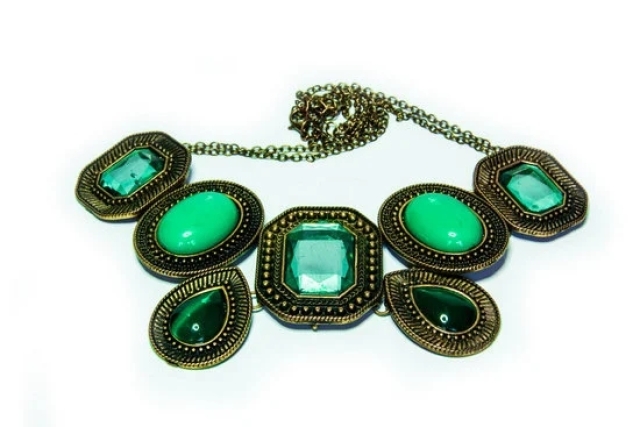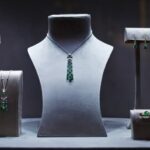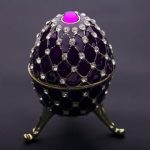The history of musical jewelry boxes dates back to 18th century France and England, when these ornate storage pieces were used to keep valuables safe. The unique feature of these boxes were that they incorporated a mechanism that enabled them to play music when opened.
This melodious injection of sound often attributed to romance and beauty, playing some the time-honored classics like Beethoven’s ‘Fur Elise’ or Schumann’s ‘The Wild Rider’. What began as elegant gifts for royalty was quickly enjoyed by all classes of society; as the collection of clocks and other items became popular in households across Europe.
As musical jewelry boxes gained traction in French high society, makers were encouraged to hone their craftsmanship with new levels of creativity and finesse. In turn, this led to a range antique boxes that embodied love, honor and loyalty story-lines told through intricate carvings on the exterior accompanied by soft melodies within. A unicorn galloping around a landscape filled with trees framed beneath the lid, or twirling ballerinas beneath glass dials had people enamored with these magical treasures.
Though musical jewelry boxes are no longer showcased in Parisian salons or adorn regal palace walls today, they remain visible tribute to quality craftsmanship which has remained in popularity over centuries. The traditional engineering principles have been imparted onto modern creations today – as it is still a labor of love for artisans who strive to capture romantic eras gone by through music-playing keepsakes that reflect our pastimes passions.
This may come in the form of recordable models that offer more personalized experiences with couples recording their voice vows or repertoire chosen specifically by family members for occasions such as graduations and birthdays.
Early History of Musical Jewelry Boxes
The Renaissance
During the Renaissance, musical jewelry boxes grew in popularity among royal families throughout Europe. Crafted out of wood and ivory, these elaborate pieces brought luxury to the court entertaiment. The intricate engravings and elaborate scenes accompanied music played on bells, drums, and organ pipes. Moving mechanical figures were also added to many of these luxury boxes creating a magnificent spectacle for people in the room who would marvel at the spectacle as part of the performance too.
The Baroque Period
The Baroque period saw an explosion initial explosion in musical jewelry box production with countries like France, Germany, Austria and Switzerland all becoming centers for artistry craftsmanship. Use of more precious materials like gold and silver became popular due to new affluence amongst royal families.
New complex mechanisms began emerging with metal levers, rods and hidden compartments adding an extra level complexity that distinguished master craftsman from novice makers. Special gems like rubies were also used solely for decoration as they weren’t connected to any other parts of the mechanism but still provided fantastic visual appeal.
19th Century
The 19th century signalled mass production of musical jewelry boxes through technologies such as steam engine powered factories which allowed one skilled engineer to control multiple machines simultaneously increasing output by hundreds of fold each day. This increased output meant prices began dropping and suddenly even more people could afford these once-luxury items making them far more accessible.
With excess production models available around manufacturers began creating different styles or shapes to cater to wider tastes offering customers variety beyond that previously available before this era. There was also a move towards simpler mechanisms which relied far less on integrated moving parts since any failure could trigger costly repairs across entire productions lines.
Popular Types of Musical Jewelry Boxes
Musical Jewelry Boxes have been popular keepsakes and gifts for centuries. These boxes, originally made of wood, have developed over time to include various types of materials including glass, ceramic and metal. Today, musical jewelry boxes remain popularly used as a way to safely store jewelry and other keepsakes while listening to the beautiful melodies playing from them.
The most traditional style of music box is the ballerina music box which remains popular with both young and old collections alike. Perhaps the most commonly recognized design, this box typically has an attached figurine that dances when the lid is opened while a tinkling melody plays overhead.
Generally constructed out of wood such as poplar, oak or walnut accompanied by an internal metal mechanism powered by cranking metal handle on the side.These simply designed ballerina boxes are often brightly painted in colors like reds, blues or greens giving them a classic fairy-tale feel.
Modern day musical jewelry boxes can vary greatly in design ranging from vintage looking pieces to ones adorned with modern designs and characters from pop culture franchises. There are even options that are customizable allowing you to choose your own tunes as well as decorations such as mirrors inside the lid or photo frames attached to the outside at no additional cost.
Many modern boxes are made out of sturdy plastic that is perfect for travel with its lightweight construction yet durable enough to keep your valuables safe.
Oriental designs also remain a favorite choice among buyers featuring intricate patterns accented by colorful gems and jewels. Although some may be just ornate decoration there are some available where small assortments of Oriental instruments play classic Chinese songs when opened adding a cultural element to a collection’s pieces. Some even come equipped with motion activated lights creating stunning visual effects when combined with the melodious sound produced.
Crafting the Musical Jewelry Boxes
The process of creating a musical jewelry box is a complex and intricate one, involving the use of specialized tools and extreme skill. A master craftsman must carefully plan the creation of a musical box with exact measurements and careful consideration given to each step in the process.
The craftsmanship involved includes working with fine woods, including exotic species, inlaying different colors and textures of wood within the boxes, as well as incorporating intricate carvings on the sides or lids. In addition, delicate machinery such as music movements must be inserted into the boxes during ha final stage in order to provide sound when opened.
Tools used in Crafting Musical Jewelry Boxes
No musical jewelry box is crafted without the use of dedicated tools and materials. These include:
- Fine Woods-Exotic species are often used since they are rarer and have unique characteristics that give them unique beauty.
- Woodworking Tools – Including saws, chisels and specialized routers
- Inlay Materials – This include mother of pearl, tortshells or abalone shells which are incorporated into the design
- Polishers & Sealers – To maintain the shine and provide protection on the wood
- Music Movements – Digital music movements are used to trigger a melody when opened.
Designs Found on Musical Jewelry Boxes
Musical jewelry boxes vary greatly in terms of design depending upon their age, origin, culture or maker. Typically though these designs not only enhance functionality but often depict some form scene or imagery. Common designs found include portraits from antique paintings to elaborate scenes depicting landscape such as lakeside mansions or faraway castles.
They can also feature animals such as birds (often pelicans), mythical beasts (unicorns) or plants like trees or flowers. Finally these motifs accompany custom details like engraving names initials into them for personal touches.
Maintenance and Care of Musical Jewelry Boxes
Musical jewelry boxes can be a beautiful and cherished keepsake. Often constructed from wood, porcelain, or metal, many of these heirloom pieces have been passed down from generation to generation. It’s important to take proper care of a musical jewelry box in order to extend its life and prevent deterioration over time.
Some general tips for keeping your jewelry box clean include using furniture polish on the outside of the box and dusting it regularly with a soft cloth. If your box has wooden components, never use water to wipe it down, as this could cause discoloration or warping. Additionally, if the locks don’t open smoothly, put a small drop of oil on them to keep them operating properly.
In order to maintain its original vibrant color and keep the wood healthy, apply a sealant every four months. If you live in an area that has high humidity levels, consider putting silica gel packs in the box, as this can help protect the wood from cracking or becoming moldy. Alternatively, another popular method is to place some sweet-smelling lavender sachets inside the drawers.
More tips for maintaining musical jewelry boxes
- Keep away from direct sunlight
- Store in cool and dry environment
- Don’t store items that could corrode under damp conditions
- Avoid strong odors like perfume
- Be careful when handling play mechanisms so as not to disturb delicate parts
The Role of Music in Jewelry Box Design
Music plays an integral role in jewelry box design. Whether it is the dulcet tones of a harp, the melodic chimes of a wind chime or the enchanting notes of a piano, music has been used throughout history as way to add aesthetic value and emotion to box designs. It is no surprise then, that musical jewelry boxes have enjoyed tremendous popularity since their invention centuries ago.
The Origins of Musical Jewelry Boxes
Musical jewelry boxes first appeared during the Baroque period in Europe, where intricate designs and complex musical compositions were produced. At that time, they were primarily made from wood, metal or porcelain and featured ornately-engraved designs with graceful melodies for added effect.
From that time onwards, the appeal of musical jewelry boxes only increased as more makers looked to create beautiful pieces with an added touch of music. Popular shapes included circular barrels, rectangular cases and even musical eggs with different playing devices such as wind-up mechanisms or traditional keys offering access to the melodies contained within them.
Modern Musical Jewelry Boxes
In recent decades, many modern jewelers have decided to add additional features such as motion sensors and LED lights into their boxes to attract buyers looking for something extra out of their purchases. Miniature versions of popular instruments are also incorporated into some designs alongside hand-painted scenery depicting popular objects such as castles or landscapes.
However, despite all these advancements in design, most popular musical jewelry boxes still retain their intricate instrumentation and melodic music notes which harken back to earlier times when they first came around.
Benefits of Owning a Musical Jewelry Box
Musical jewelry boxes are a beloved item for many, providing an emotional connection to cherished memories and cultural identity. Since their introduction in England during the 16th century, these pieces have seen a series of modernizations and updates to keep up with the ever-changing demand for pleasing form and function. Here are some of the benefits of owning a musical jewelry box:
- Psychological Benefits – Throughout history, people have expressed strong emotional attachments to music and personal possessions. Such sentiments can be further increased with musical jewelry boxes, offering an avenue to express one’s personal style while listening to their favorite tunes.
- Protection and Organization – Music boxes provide a safe place for smaller items such as earrings, necklaces, watches and rings. This not only provides peace of mind knowing that prized possessions are kept safely in place but also makes it easier to find items quickly when needed.
- Aesthetic Appeal – Musical jewelry boxes come in various shapes, sizes, colors and materials; from plastic models with cartoon character themes to handcrafted wooden creations from exclusive artisans. Regardless of preference or budget, musical jewelry boxes represent a chance to add flair and personality into any room.
Conclusion
The history of musical jewelry boxes is as varied and interesting as the many types of jewelry boxes themselves. Throughout the centuries, people have crafted intricate and exotic designs to both serve their purpose and beautify any space. From the handcrafted wooden boxes of the 1700s to the extravagant mechanical mechanisms of today, musical jewelry boxes have long held an important role in society, making them a treasured item for generations of jewelry aficionados.
Musical jewelry boxes have always been deeply intertwined with various cultures, from wishing someone good wishes in Spain to giving gifts during birthdays in Japan. As time has progressed, so too has the technology surrounding these magical treasures; advances like digital sound recordings mean that musical jewelry boxes can now play your favorite tunes for you at a moment’s notice.
Most recently, music box makers are even adding images and video displays on LED screens for an even more immersive experience.
Throughout time, musical jewelry boxes have been far more than just decorative pieces; they are objects that capture nostalgia and bring joy to those who listen to their soothing melodies.
They also stand as monuments not only to a person’s love affair with music but also their love affair with each other or another culture altogether; most often it is through small items like these that we form memories with loved ones or appreciate different customs from around the world.
Whether you’re gifting one to a beloved friend or merely listening to its lulling serenades every once in awhile, there’s no denying that musical jewelry boxes have had an unforgettable impact on our lives throughout history.

Welcome to my jewelry blog! My name is Sarah and I am the owner of this blog.
I love making jewelry and sharing my creations with others.
So whether you’re someone who loves wearing jewelry yourself or simply enjoys learning about it, be sure to check out my blog for insightful posts on everything related to this exciting topic!





